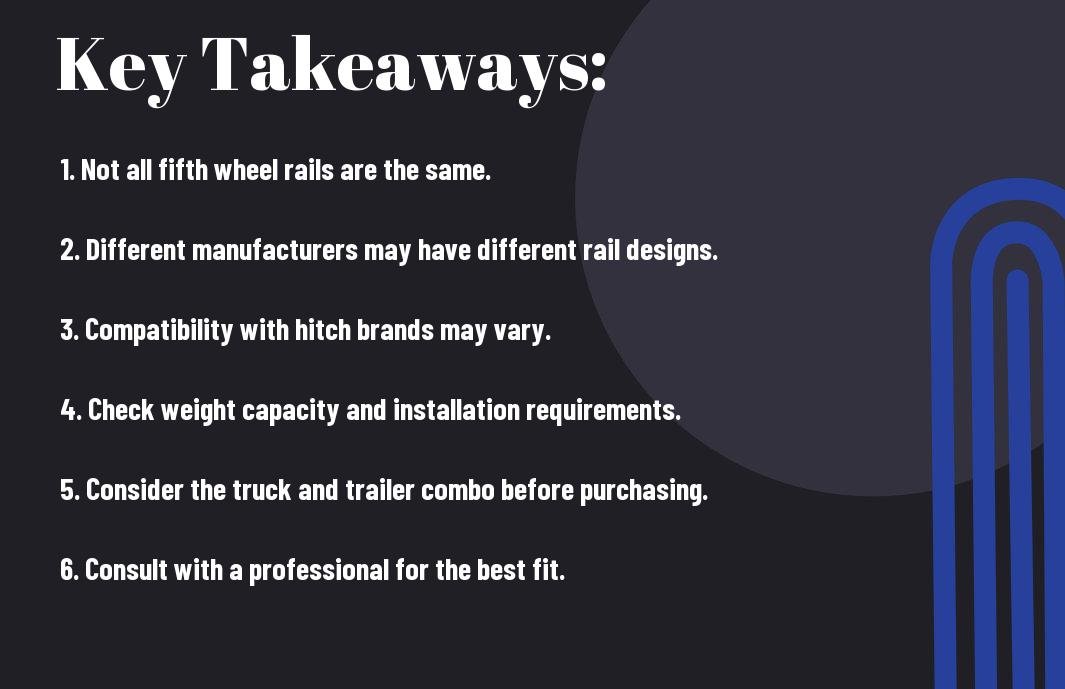When considering purchasing fifth wheel rails for your truck, you may be wondering if all options on the market are created equal. The truth is, not all fifth wheel rails are the same, and it’s crucial to understand the differences before making a purchase. Using the wrong type of rail can lead to dangerous situations on the road, causing potential accidents and damage to your vehicle. In this blog post, we will explore the various types of fifth wheel rails available, their differences, and why it’s important to select the right one for your specific needs. By the end, you’ll have a clear understanding of the importance of choosing the correct fifth wheel rails for your truck, and you’ll be able to confidently make an informed decision on which option is best for you.
Key Takeaways:
- Not all fifth wheel rails are the same in terms of size, weight capacity, and compatibility with different truck models.
- It is crucial to match the fifth wheel rails with the specific requirements of your truck and the fifth wheel hitch you plan to use.
- Compatibility between the fifth wheel rails and the hitch is essential to ensure a secure and safe towing experience.
- Consider factors such as weight capacity, size, and installation requirements when choosing the right fifth wheel rails for your truck.
- Proper installation of the fifth wheel rails is crucial to ensure the safety and stability of your towing setup.
- Consult with a professional or the manufacturer to ensure you are choosing the correct fifth wheel rails for your specific towing needs.
- Investing in high-quality, durable fifth wheel rails will provide peace of mind and long-term reliability for your towing adventures.

Understanding Fifth Wheel Rails
Assuming you are new to the world of fifth wheel hitches, you may not be familiar with the important role that fifth wheel rails play in the towing process. Fifth wheel rails are the foundation of the hitch, providing a secure connection between your truck and trailer. As such, it’s crucial to understand the different aspects of fifth wheel rails to ensure the safety and efficiency of your towing setup.
Basic Design and Function
When it comes to the basic design and function of fifth wheel rails, it’s essential to recognize that they are typically made from heavy-duty steel to provide maximum strength and durability. The rails are installed in the bed of your truck and serve as the attachment point for the fifth wheel hitch. Their primary function is to distribute the weight of the trailer evenly across the truck’s frame, allowing for a smooth and stable towing experience. Proper installation and maintenance of the fifth wheel rails are crucial for safe towing, so be sure to follow the manufacturer’s guidelines closely.
Variations Across Brands and Models
It’s important to note that not all fifth wheel rails are the same across different brands and models. While the basic design and function remain consistent, there can be variations in terms of size, weight capacity, and compatibility with specific hitches. It’s vital to select fifth wheel rails that are compatible with your truck and hitch, ensuring a secure and reliable connection. Additionally, choosing reputable brands known for their quality and reliability can provide added peace of mind when it comes to towing your trailer.
Compatibility and Interchangeability
Your fifth wheel rails determine the compatibility and interchangeability of your towing equipment. It’s important to understand the industry standards and customization options available, as well as the factors that influence rail compatibility.
Industry Standards and Customization
When it comes to fifth wheel rails, there are industry standards that manufacturers adhere to. However, there are also customization options available to cater to specific needs and preferences. Some manufacturers offer custom rails that are designed to fit specific truck makes and models, while others provide universal rails that can be adjusted to fit a variety of trucks. It’s important to consider your specific towing setup and do thorough research to ensure that you’re getting the right rails for your vehicle.
Factors Influencing Rail Compatibility
Several factors can influence the compatibility of fifth wheel rails with your towing setup. The length and width of the rails, as well as the mounting hole patterns, are critical factors to consider. Additionally, the weight capacity and construction materials of the rails play a crucial role in determining their compatibility with your fifth wheel hitch. Recognizing these factors and ensuring that the rails you choose are compatible with your specific truck and towing needs is essential for safe and efficient towing.
- Length and width: Ensure that the rails are the right size for your truck bed and provide a secure fit for the fifth wheel hitch.
- Mounting hole patterns: Check that the rails’ hole patterns align with the mounting points in your truck bed for proper installation.
- Weight capacity and materials: Consider the weight of your trailer and ensure that the rails are constructed with durable materials capable of supporting the load.
Installation and Safety Considerations
After you have chosen the fifth wheel rails that are compatible with your truck and trailer, it is important to understand the installation process and safety considerations that come with it. Proper installation is crucial for the overall safety and performance of your towing setup.
Professional Installation vs. DIY Approach
When it comes to installing fifth wheel rails, you have the option of hiring a professional or taking on the task yourself. While a DIY approach may seem more cost-effective, it’s important to consider the potential risks involved. Improper installation can lead to serious safety hazards, including trailer detachment and loss of control while towing. If you are not confident in your abilities to install the rails correctly, it may be best to leave it to the professionals. Your safety, as well as the safety of others on the road, should always be a top priority.
Ensuring Proper Fit and Function
Ensuring that the fifth wheel rails are properly fitted to your truck is essential for safe towing. A loose or improperly secured rail can lead to instability and potential accidents on the road. Before hitting the road, you must thoroughly inspect the installation to ensure everything is securely fastened and in proper working order. Additionally, you should always follow the manufacturer’s recommendations for maintenance and regularly inspect the rails, ensuring they are free from any damage or wear that could compromise their function. Your diligence in this regard can make all the difference in the safety and performance of your towing setup.
Selection and Maintenance
Now that you understand the basics of fifth wheel rails, it’s important to know how to select the right one for your vehicle and how to maintain it to ensure longevity and performance.
Choosing the Right Fifth Wheel Rails for Your Vehicle
When it comes to choosing the right fifth wheel rails for your vehicle, there are a few key factors to consider. Firstly, you need to ensure that the rails are compatible with your specific make and model of truck. Check the weight capacity and dimensions of the rails to ensure they can handle the load of your trailer. Additionally, consider the installation process and whether it aligns with your skill level. Finally, look for reputable brands and read customer reviews to ensure you’re choosing a high-quality product.
Maintenance Tips for Longevity and Performance
Maintaining your fifth wheel rails is crucial for both longevity and performance. Regularly inspect the rails for any signs of wear or damage, and make sure to clean them after every use to prevent corrosion. Applying lubricant to the moving parts can help reduce wear and tear and ensure smooth operation.
- Check for loose bolts and tighten them if necessary
- Inspect for any rust or corrosion and remove it promptly
- Keep the area around the rails clean to prevent debris accumulation
- Always follow the manufacturer’s recommended maintenance schedule
Perceiving these maintenance tips will help ensure your fifth wheel rails continue to perform at their best.
To Wrap Up
It’s important to remember that not all fifth wheel rails are the same. When looking to purchase or install a fifth wheel rail system, it’s crucial to ensure that the rails are compatible with your specific truck model and that they meet the towing capacity requirements for your intended use. Take the time to research and compare different brands and models to find the right fit for your truck and towing needs. Doing so will ensure a safe and secure towing experience, and provide you with peace of mind on the road.
FAQ
Q: Are all fifth wheel rails the same?
A: No, not all fifth wheel rails are the same. They vary in size, weight capacity, and mounting options. It’s important to select the correct rails that are compatible with your specific fifth wheel hitch.
Q: What factors should I consider when choosing fifth wheel rails?
A: When selecting fifth wheel rails, consider the weight capacity, rail length, and whether they have a universal or custom-fit design for your truck. Other factors to consider include the material, installation requirements, and compatibility with your fifth wheel hitch.
Q: Do all fifth wheel hitches fit any set of rails?
A: No, not all fifth wheel hitches fit any set of rails. It’s essential to ensure that the fifth wheel hitch and rails are compatible. Some hitches require specific rail designs or mounting systems, so it’s crucial to verify compatibility before making a purchase.
Q: Can I install fifth wheel rails myself?
A: The installation of fifth wheel rails typically requires some technical knowledge and may involve drilling into the truck bed. While some experienced DIY enthusiasts may be able to handle the installation, it’s recommended to have the rails installed by a professional to ensure proper alignment and secure mounting.
Q: What are the most common materials used for fifth wheel rails?
A: Fifth wheel rails are commonly constructed from steel or aluminum. Steel rails are known for their durability and strength, while aluminum rails are lighter in weight. The choice between steel and aluminum rails depends on factors such as towing capacity, truck bed weight limits, and personal preference.
